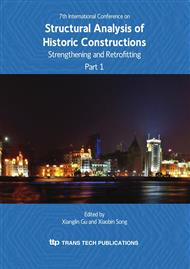p.929
p.935
p.941
p.947
p.953
p.959
p.965
p.971
p.977
The S. Marco Church in L’Aquila: Provisional Interventions after the 2009 Abruzzo Earthquake
Abstract:
The 6th of April 2009 a strong earthquake (rated 5.8 on the Richter scale) struck the Abruzzo region in central Italy, causing hundreds of casualties and devastating the historical city of L’Aquila and several small towns in the area. The toll in terms of structural damage was enormous, also considered that a vast amount of buildings was made of poorly arranged masonry composed by round pebbles and mortar of scarce mechanical characteristics. In particular, the buildings belonging to cultural heritage (e.g. churches and monumental buildings) were between the structures that suffered more from seismic damage, considered their dimensions, mass and general lack of adequate connections. Few weeks after the seismic event, a church in the historical city centre of L’Aquila, the S. Marco church, was “adopted” by the Italian Veneto Region, which paid and provided the necessary technical support for the first necessary provisional structural interventions. The paper describes the steps undertaken in order to provide the building with the minimum safety conditions necessary to face the aftershocks, and to survive without further collapses to be subsequently retrofitted. A static and dynamic structural monitoring system was also installed in the church since the beginning of the works, in order to control the safety conditions of the area during the execution of the interventions and to assess the damage progression or stationariness.
Info:
Periodical:
Pages:
953-958
Citation:
Online since:
October 2010
Price:
Сopyright:
© 2010 Trans Tech Publications Ltd. All Rights Reserved
Share:
Citation:



